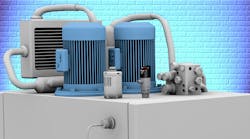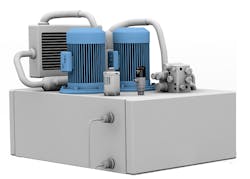Most industrial hydraulic power units (HPUs) are located in less-than-accessible areas, such as cellars, utility rooms, or among other machines crowded around them. If an HPU is not easily accessible, it’s less likely to be closely monitored. This means oil level, temperature, cleanliness, and other important operating conditions could go undetected, potentially leading to a breakdown.
Monitoring the HPU should occur with the hydraulic system running. However, depending on its location, the HPU may have to be checked during scheduled downtime. The problem is that many undesirable conditions (especially low oil level during cycling) only emerge while hydraulic systems are in operation. Furthermore, if the HPU is remotely located, someone needs to physically check the status of fill levels for each HPU. In large facilities, monitoring dozens of hydraulic power units can be almost a full-time job.
Give HPUs the Smarts
Ideally, HPUs should be monitored continuously. This would obviously be an impractical use of labor. However, a practical and even more effective alternative is a smart HPU. A smart HPU has all of the elements of a traditional hydraulic power unit, but is fitted with electronic instrumentation to monitor key parameters. As a result, a smart HPU provides alerts that act as preventive maintenance to improve hydraulic-system reliability and service life, thereby reducing downtime. An added benefit is that the feedback from sensors can be used in statistical process control and other factory automation communications.
Adding electronic monitoring to an existing HPU or specifying it for a new application is a wise investment. And the good news is you don’t have to invest a ton of money all at once to upgrade all HPUs in your plant. Instead, you could start with the HPUs driving the most critical operations and fit them with only the bare necessities: fluid level and fluid temperature sensing.
Doing your homework can pay off, because some manufacturers offer level sensors with built-in temperature detection. Fluid contamination is also important; and although a wise investment, much of this online particle instrumentation can be expensive. Invest in technology that offers ease of expandability and integration in a step-by-step approach.
Getting Started
First, identify the most important characteristics for measurement that would allow for the most impact on your process improvement. With the lean philosophy in mind, you may need to investigate what technology can help standardize cables or hardware or technology itself. For example, IO-Link is one of the technologies that enables standardizing on cables and allows for integration of various smart sensors. IO-Link offers smart communication of process data, parameter data, and event data on the same three- or four-wire unshielded proximity cable.
Almost as many different ways exist to communicate the sensor information, considering they are sensors themselves. Traditional sensors provide analog output, with 4 to 20 mA or 0 to 10 V used most often in hydraulic systems.
The problem with analog measurement is that it requires shielded cables between the sensor and the control cabinet. Shielded cables cost more and need special care when installed, because they may be sensitive to the electrical noise from vibration or high currents transmitted to electric motors. Another drawback of analog signals is that their output must be scaled to convert it to proper engineering units.
IO-Link
A workaround that eliminates the need for shielded cables’ expensive analog-conversion cards in the controller is to use the aforementioned IO-Link technology. IO-Link also offers enhanced diagnostics and parameterization features that make it easy to replace a sensor simply by plugging in a new one.
Because IO-Link is point-to-point communication, it requires an IO-Link master or a gateway module that collects the IO-Link data from all of the sensors and sends it to the controller in consolidated fashion—tremendously reducing hardware and assembly costs. The IO-Link master module typically offers data collection from eight IO-Link sensors. Therefore, depending on requirements for the data, one IO-Link Master module could collect information from one or multiple HPUs at once.
The collected information is then sent to the controller over a fieldbus or an industrial network of choice. Because so many different fieldbuses and networks are available, IO-Link offers another advantage by making your sensor’s fieldbus independent. The IO-Link master (gateway) would be the only fieldbus- or network-dependent device in a system.
This information was provided by Balluff Inc., Florence, Ky. For more information, call (800) 543-8390, or visit the company's website.



